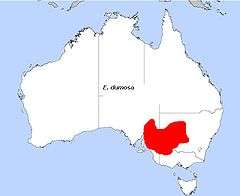Eucalyptus dumosa
| White mallee | |
|---|---|
 | |
| Eucalyptus dumosa, Melbourne | |
| Scientific classification | |
| Kingdom: | Plantae |
| (unranked): | Angiosperms |
| (unranked): | Eudicots |
| (unranked): | Rosids |
| Order: | Myrtales |
| Family: | Myrtaceae |
| Genus: | Eucalyptus |
| Species: | E. dumosa |
| Binomial name | |
| Eucalyptus dumosa A.Cunn. ex J.Oxley | |
 | |
| E. dumosa, field distribution | |
.jpg)
Eucalyptus dumosa, commonly known as the Walkerie mallee,[1] Congoo mallee, Cong mallee, Dumosa mallee[2] or the White Mallee, is a mallee of south eastern Australia. Mallee is the Wergaui/ Wotjobaluk word for this species.[3]
Description
The tree typically grows to a height of 4 to 8 metres (13 to 26 ft)[4] and occasionally 12 metres (39 ft)[5] and a width of 4 to 5 metres (13 to 16 ft) and has an open canopy. It has an open, bushy, spreading habit.[4] The bark is smooth, whitish or yellow-white, weathering to grey or pinkish-grey, on larger stems there is usually a stocking of thin grey-brown fibrous bark.[6] The bark sheds in long thin ribbons.[5]
Adult leaves are stalked, alternate, lanceolate 10 centimetres (3.9 in) long and 2 centimetres (0.8 in) wide, concolorous dull green to grey-green.[6]
Clusters of white flowers appear in late summer to mid autumn.[6] The infloresences are seven-flowered umbellasters with a terete or angular peduncle that is 10 to 16 mm (0.39 to 0.63 in) long. It has pedicels that are terete and 1 to 3 mm (0.04 to 0.12 in) long and cylindrical buds. The fruit that forms later is cylindrical or ovoid and 6 to 9 mm (0.24 to 0.35 in) in length with a diameter of 5 to 7 mm (0.20 to 0.28 in).[5]
Range
It is found in the relatively dry country of South Australia from the northern Flinders Ranges and Murray Mallee eastwards to central western New South Wales and north western Victoria.[3] E. dumosa is usually co-dominant in mallee shrubland on red aeolian sands.[5]
Uses
The leaves are steam distilled as a commercial source of cineole based eucalyptus oil.[7]
It is used as a component of mass plantings along with other mallee species on wide roadside verges as a screen, wind-break, erosion control or a shade tree. Indigenous Australians use the tree as a source of food, drink, medicines and to make containers and implements.[4]
A sweet manna-like substance is produced upon the leaves of the tree, it is made into a drink. The bark of young roots is baked and eaten, it is sweet, resembling malt in flavour.[8]
See also
References
- ↑ Dean Nicolle. "Native Eucalypts of South Australia". Retrieved 16 October 2016.
- ↑ "Eucalyptus dumosa". Lucid. Retrieved 16 October 2016.
- 1 2 "Mallee". Viridians. Retrieved 16 October 2016.
- 1 2 3 "Eucalyptus dumosa White Mallee". Plant Selector. Botanic Gardens of South Australia. Retrieved 16 October 2016.
- 1 2 3 4 "Eucalyptus dumosa A.Cunn. ex J.Oxley". PlantNet. Royal Botanic Garden, Sydney. Retrieved 16 October 2016.
- 1 2 3 Brooker, M.I.H. & Kleinig, D.A. Field Guide to Eucalyptus, Bloomings, Melbourne 2001
- ↑ Boland, D.J., Brophy, J.J., and A.P.N. House, Eucalyptus Leaf Oils, 1991, p6 ISBN 0-909605-69-6
- ↑ "Eucalyptus dumosa - Cunn.". Plants For A Future. Retrieved 16 October 2016.